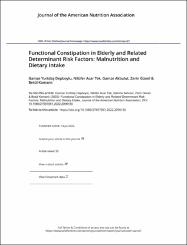| dc.contributor.author | Depboylu Yurtdaş, Gamze | |
| dc.contributor.author | Tek Acar, Nilüfer | |
| dc.contributor.author | Akbulut, Gamze | |
| dc.contributor.author | Günel, Zerin | |
| dc.contributor.author | Kamanlı, Betül | |
| dc.date.accessioned | 2022-07-29T13:56:52Z | |
| dc.date.available | 2022-07-29T13:56:52Z | |
| dc.date.issued | 2022 | en_US |
| dc.identifier.citation | Gamze Yurtdaş Depboylu, Nilüfer Acar Tek, Gamze Akbulut, Zerin Günel & Betül Kamanlı (2022) Functional Constipation in Elderly and Related Determinant Risk Factors: Malnutrition and Dietary Intake, Journal of the American Nutrition Association, DOI: 10.1080/27697061.2022.2096150 | en_US |
| dc.identifier.issn | 2769-7061 / 2769-707X | |
| dc.identifier.uri | https://doi.org/10.1080/27697061.2022.2096150 | |
| dc.identifier.uri | https://hdl.handle.net/20.500.12809/10160 | |
| dc.description.abstract | Aim The objective of this study was to evaluate the relationship between FC and physical activity, dietary intake and malnutrition in the elderly. Method A cross-sectional study was conducted on 883 adults aged >65 years from nursing homes and community health centers in Turkey. Constipation status was evaluated according to Rome IV criteria and Bristol Stool Form Scale. Dietary intake was assessed using a food consumption record (24-hour food recall). The dietary energy and nutrients were analyzed using the "Nutrition Information Systems Package Program". The nutritional status of participants was evaluated using the Mini-Nutritional Assessment (MNA) test. The International Physical Activity Questionnaire (IPAQ, short form) was used to assess physical activity status. Results Among the 883 participants, 29.6% were classified into the FC group (32.2% of females, 25.8% of males). The FC group had significantly lower total energy, fluid, water, protein, carbohydrate, magnesium, zinc, phosphorus, potassium, soluble fiber, insoluble fiber, total fiber, and fiber (g)/1000 kcal intake than the non-FC group (p < 0.05). The multivariate logistic regression analysis showed that total dietary fiber intake was significantly associated with a lower prevalence of FC (OR: 0.98, 95% Cl: 0.96-0.99). According to MNA, participants at risk of malnutrition (OR: 5.21, 95% Cl: 3.09-9.77) and malnourished participants (OR: 3.03, 95% Cl: 1.62-5.68) had a greater likelihood of FC compared with normal participants. Participants in the middle lower quartile of water intake (OR: 0.63, 95% CI: 0.42-0.95) had a decreased likelihood of FC compared with participants in the lowest quartile. Conclusion FC is a common gastrointestinal disorder among the elderly in Turkey. Low dietary fiber intake, low water intake and malnutrition were important risk factors associated with FC in the elderly. | en_US |
| dc.item-language.iso | eng | en_US |
| dc.publisher | ROUTLEDGE JOURNALS | en_US |
| dc.relation.isversionof | 10.1080/27697061.2022.2096150 | en_US |
| dc.item-rights | info:eu-repo/semantics/closedAccess | en_US |
| dc.subject | Functional constipation | en_US |
| dc.subject | Malnutrition | en_US |
| dc.subject | Water intake | en_US |
| dc.subject | Fiber intake | en_US |
| dc.title | Functional Constipation in Elderly and Related Determinant Risk Factors: Malnutrition and Dietary Intake | en_US |
| dc.item-type | article | en_US |
| dc.contributor.department | MÜ, Sağlık Bilimleri Fakültesi, Beslenme ve Diyetetik Bölümü | en_US |
| dc.contributor.institutionauthor | Günel, Zerin | |
| dc.relation.journal | JOURNAL OF THE AMERICAN NUTRITION ASSOCIATION | en_US |
| dc.relation.publicationcategory | Makale - Uluslararası Hakemli Dergi - Kurum Öğretim Elemanı | en_US |


















